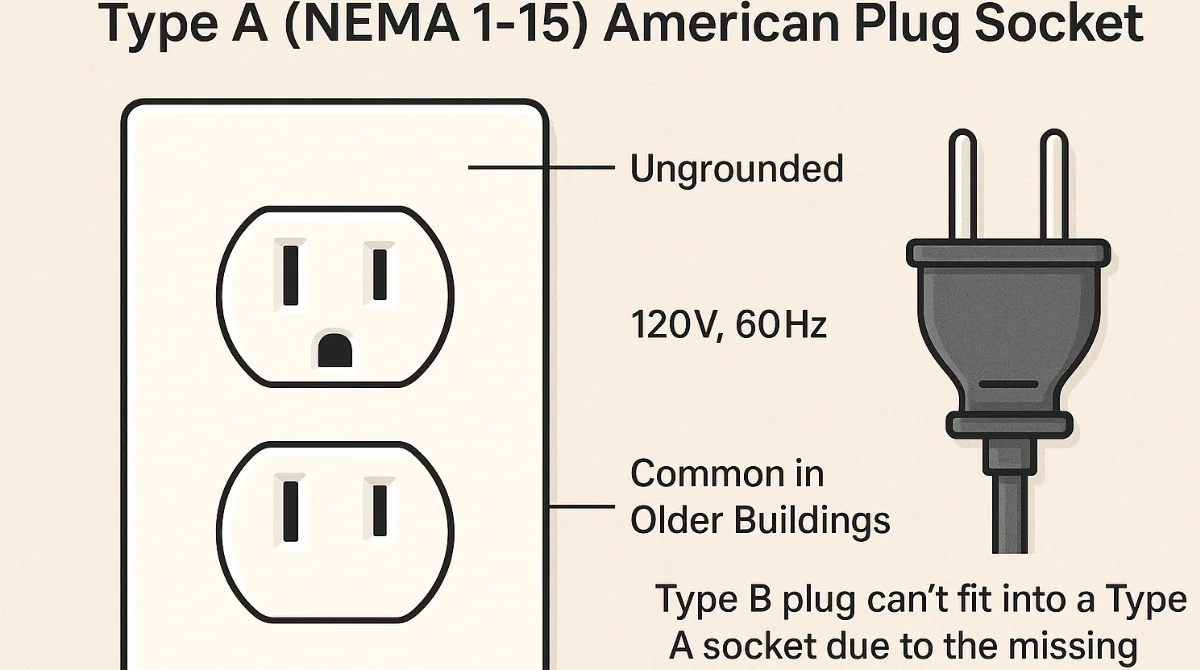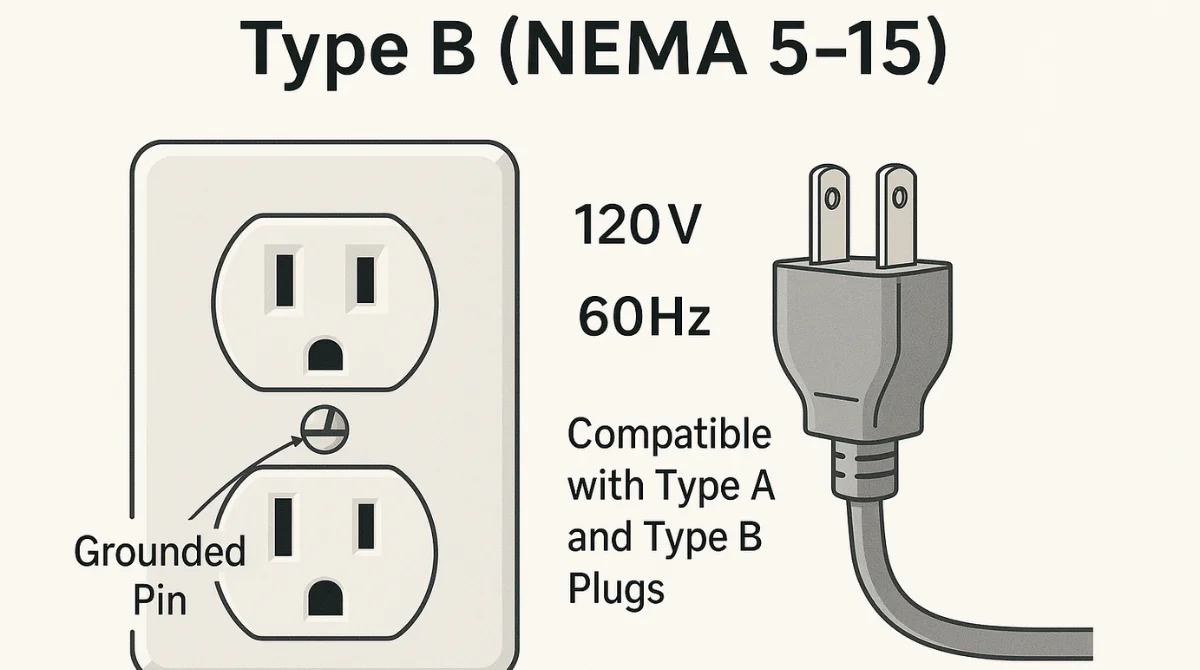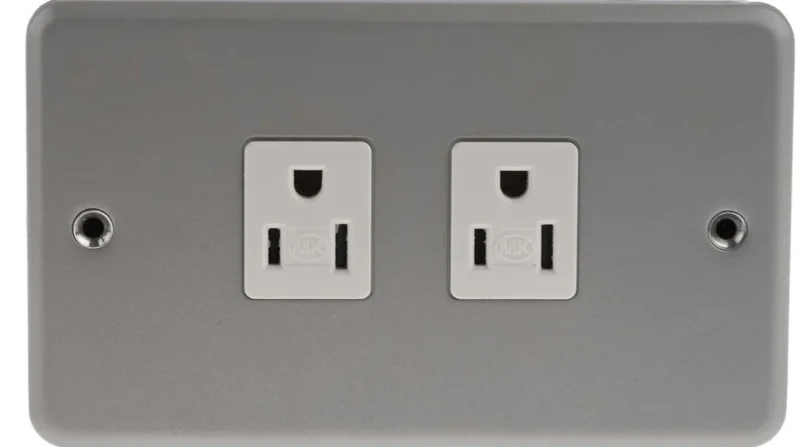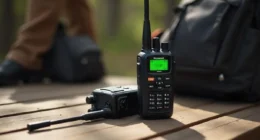Table of Contents
When traveling to or residing in the United States, it’s essential to understand the types of plug sockets used, their voltage specifications, and safety considerations. This knowledge ensures that your electronic devices function correctly and safely.
Types of American Plug Sockets
In the United States, there are two main types of plug sockets that you will commonly encounter: Type A and Type B. Each type has distinct features, and their use is largely determined by the age of the building and the type of device being powered.
1. Type A (NEMA 1-15)

- Ungrounded: Type A sockets are ungrounded, which means they lack the extra grounding pin that helps prevent electrical shocks in the event of a fault. These sockets only have two flat parallel pins.
- Common in Older Buildings: Type A sockets are mostly found in older buildings or homes. They’re typically used for simpler devices that don’t require grounding, such as lamps, small electronics, or battery-powered chargers.
- Voltage and Frequency: Like all standard U.S. sockets, Type A operates at a voltage of 120 volts with a frequency of 60 Hz.
- Compatibility: While Type A plugs can fit into Type B sockets, it’s important to note that the reverse is not true. You can’t plug a Type B plug (which has an additional round grounding pin) into a Type A socket because the grounding pin would be blocked.
2. Type B (NEMA 5-15)

- Grounded: Type B sockets include not only two flat parallel pins but also a round grounding pin. This grounding pin helps ensure safety by directing excess electricity to the ground, which reduces the risk of electric shock or fire hazards.
- Standard in Newer Constructions: Type B sockets are more commonly found in newer buildings and are used for a wider range of appliances, from kitchen appliances to computers, because the grounding feature adds an important layer of safety.
- Voltage and Frequency: Like Type A, Type B operates at 120 volts and 60 Hz. However, the key difference is the additional grounding pin in the Type B socket.
- Compatibility: Type B sockets are designed to accept both Type B and Type A plugs. This means you can plug in devices that use Type A plugs into a Type B socket, but you cannot use a Type B plug in a Type A socket because of the extra grounding pin.
Type A is more common in older constructions, mainly for low-power devices, while Type B is the standard in modern electrical installations because of its added safety features. Understanding these differences is important when traveling or using electronic devices in the U.S.
Voltage and Frequency Considerations
In the U.S., the standard electrical system operates on 120 volts with a frequency of 60 Hz (hertz). This is significantly different from many other countries, where the standard voltage is typically 220-240 volts and the frequency is 50 Hz.
- Voltage refers to the electrical pressure that pushes electricity through a circuit. Different countries have different voltage standards, and using a device that is not compatible with the local voltage can cause it to malfunction or get damaged.
- Frequency refers to the number of cycles per second of the electrical current. In the U.S., the frequency is 60 Hz, whereas in many other countries, it is 50 Hz.
For example, if you try to use a device that is designed for 220-240 volts (common in Europe, Asia, and many other regions) without a proper voltage conversion, the device may burn out or stop working. This is because the higher voltage could overwhelm the components inside the device.
Dual Voltage Devices
Some modern electronic devices are designed to handle a range of voltages, typically from 110V to 240V. These devices are called dual voltage devices.
- Dual voltage devices are built to automatically adjust to different voltages and can work in both 120V systems (like in the U.S.) and 220-240V systems (common in other parts of the world). This feature is common in smaller devices such as laptops, smartphones, cameras, and electric shavers.
- For these devices, you only need a plug adapter (to fit the plug shape to the local socket) when traveling between countries with different plug types. No voltage converter is needed because the device can adapt to both voltage levels.
Single Voltage Devices
On the other hand, single voltage devices are designed to work with only one specific voltage (either 110V or 220V, for example). These devices cannot automatically adjust to different voltages and, if used incorrectly, can be damaged.
- For devices that are single voltage, if you plan to use them in a country with a different voltage, you’ll need to use a voltage converter or transformer to safely adjust the voltage. This ensures that the device receives the correct amount of electrical power it was designed for.
- Converters are typically used for short-term use with small devices like hairdryers, travel irons, or other high-power gadgets. They temporarily step down or step up the voltage but are not suitable for continuous, long-term use.
- Transformers, however, are more robust and can handle long-term use with devices like refrigerators, television sets, or other appliances that consume a lot of power.
Safety Features in American Plug Sockets
Safety is a critical aspect of electrical systems, and American plug sockets are designed with several important features to enhance user safety. These safety features aim to protect people from electrical hazards such as electric shocks or fires. Here are some key safety features in American sockets:
1. Grounding
- In Type B plugs, there is an additional grounding pin (the round pin). This pin directs any excess or stray electrical current safely into the ground, which significantly reduces the risk of electric shock. If a device develops a fault and electricity starts to leak, grounding helps to safely discharge the current rather than letting it build up, preventing injury or fire hazards.
- Grounding is especially important for higher-power devices such as computers, refrigerators, and air conditioners that might generate excess electrical current during use.
2. Polarization
- Many plugs used in the U.S. are polarized, which means that one of the two flat prongs is wider than the other. This design ensures that the plug can only be inserted into the socket in one specific orientation.
- The benefit of polarization is that it ensures electricity flows in the correct direction, preventing potential problems with electrical devices that could arise if the direction of flow were reversed. This adds a layer of safety by ensuring that devices are powered properly.
3. Tamper-Resistant Receptacles
- Tamper-resistant receptacles are designed to prevent objects (such as coins, keys, or small tools) from being inserted into the socket, which could otherwise result in electrical shocks or short circuits.
- This feature is particularly important in homes with children, as it protects them from accidentally inserting objects into the sockets, which could cause serious injuries or electrical hazards.
4. Ground Fault Circuit Interrupters (GFCIs)
- GFCIs are safety devices that detect imbalances in the electrical current and automatically cut off the power to prevent electrical shock. They are especially useful in areas where electrical devices are more likely to come into contact with water, such as bathrooms, kitchens, or outdoor outlets.
- When a GFCI detects a difference between the hot and neutral wires, it quickly interrupts the circuit, cutting off power to the connected device. This feature is crucial for preventing accidents and electrocution in wet or damp environments.
Using International Devices in the U.S.
When bringing devices from other countries to the U.S., there are several important factors to consider to ensure your devices work safely and efficiently:
Plug Shape
- Plugs in other countries may have different shapes or pin arrangements compared to the American standard. For example, European plugs have round pins, while U.S. plugs have flat ones.
- To use your device in the U.S., you’ll need a plug adapter to convert the shape of your plug so that it fits into U.S. sockets. Without this adapter, you won’t be able to physically plug your device into the socket.
Voltage Compatibility
- Electrical systems in different countries often operate at different voltages. The U.S. operates at 120V, while many other countries, such as those in Europe, use 220-240V.
- Before using a device from abroad, you need to check whether it is dual voltage (meaning it can handle both 120V and 220-240V). If your device is not dual voltage, you’ll need a voltage converter or transformer to adjust the voltage to match the U.S. standard. Using a device designed for higher voltage in the U.S. without conversion can damage the device.
Frequency Differences
- Another consideration is the frequency of the electrical current. In the U.S., the standard frequency is 60 Hz, whereas in many other countries, it is 50 Hz.
- Some devices, especially motors and clocks, are designed to operate at a specific frequency, and may not function properly or could get damaged if used with a frequency that differs from what they were designed for. Therefore, it’s essential to check the frequency compatibility of your device before use.
Purchasing Adapters and Converters
To ensure your devices are compatible with U.S. sockets and voltage, you may need to purchase plug adapters, voltage converters, or transformers. These accessories help bridge the gap between different electrical standards.
- Plug Adapters are necessary if the shape of your plug differs from U.S. sockets. They simply allow your foreign plug to fit into the socket.
- Voltage Converters are useful for devices that are not dual voltage. They adjust the voltage level to make sure your device gets the correct power supply.
- Transformers are more heavy-duty converters used for devices that require continuous voltage adjustment, such as large appliances.
You can easily find adapters and converters both online and in physical stores before you travel. It is recommended to buy them in advance to ensure that your devices are ready to use when you arrive in the U.S.
Conclusion
In conclusion, understanding American plug sockets is essential for the safe and proper use of electrical devices. By familiarizing yourself with the two main types of plugs, Type A and Type B you can ensure compatibility with U.S. outlets. Additionally, knowing the standard voltage of 120V and frequency of 60 Hz helps prevent damage to devices not designed for these specifications. Safety features like grounding, polarization, tamper-resistant receptacles, and GFCIs further enhance protection. When traveling to the U.S., checking for dual voltage compatibility or using voltage converters ensures your devices function safely. Understanding these factors guarantees that your electronics operate efficiently and without risk.









